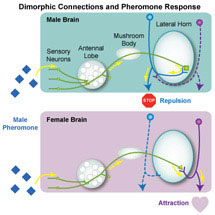 Sexual attraction between males and females could be down to differences in the way the brain is wired up, according to work from the lab of Dr Greg Jefferis at LMB. The research was carried out in fruit flies in collaboration with colleagues at the Research Institute of Molecular Pathology (IMP) in Vienna.
Sexual attraction between males and females could be down to differences in the way the brain is wired up, according to work from the lab of Dr Greg Jefferis at LMB. The research was carried out in fruit flies in collaboration with colleagues at the Research Institute of Molecular Pathology (IMP) in Vienna.
Fruit flies share many genes with mammals, and are at the forefront of research into the neural basis of behaviour. The scientists studied fly neurons expressing a gene called fruitless which is present in less than 5% of the 100,000 brain neurons. Fruitless is normally only active in male flies, where it is important for controlling sexual identity. Earlier research at the IMP showed that female flies manipulated to express the Fruitless protein in their brain cells will try to court normal female flies. So the fruitless gene, and the approximately 2000 neurons in which it is expressed, are clearly very important for controlling the sexual behaviour of the fly.
The new study investigated how neurons expressing fruitless are wired up. They identified the majority of differences between male and female fly brains both at the level of brain shape and at the level of differences in wiring. These included differences in neurons carrying information about a male pheromone – a scent given off by male flies. Signals initially followed the same path through two layers of neurons. But at the third neuronal layer, the connections suddenly diverged in males and females. This may explain why female flies like the scent and males do not.
Greg, who led the research, explains: “Previous work in mice has shown that pheromones are critical for regulating sex-specific behaviour, but has yet to identify wiring differences in the brain that might explain why the same smell is processed differently by each sex. This is what we seem to have found in the fly. Now we are working hard to prove that these wiring differences really do alter brain function and behaviour.”
Further references:
Paper in Current Biology
Greg Jefferis’ Group Leader Page
Research Institute of Molecular Pathology